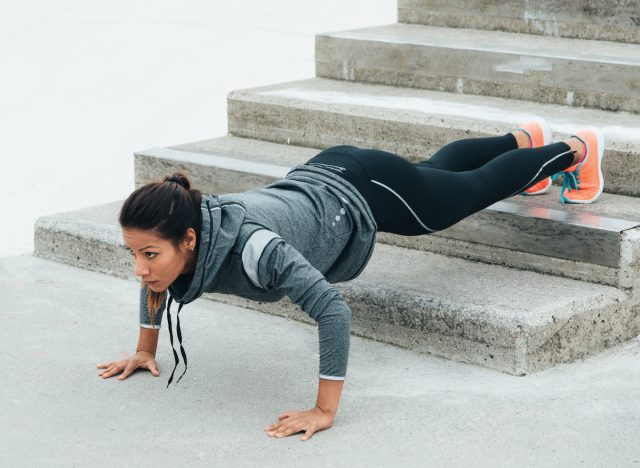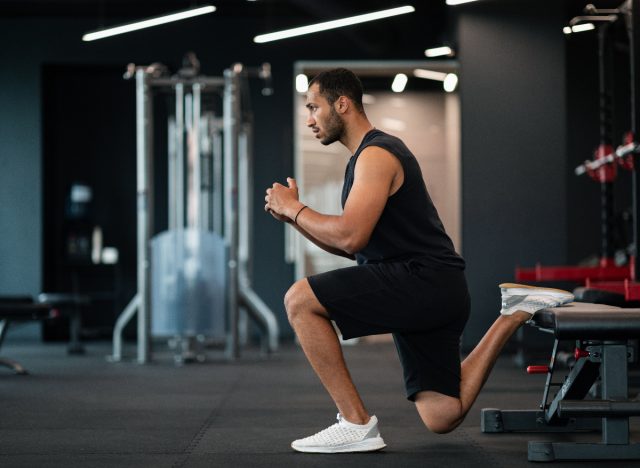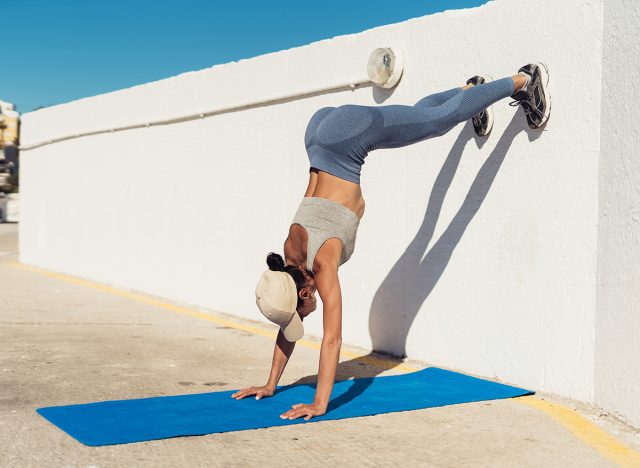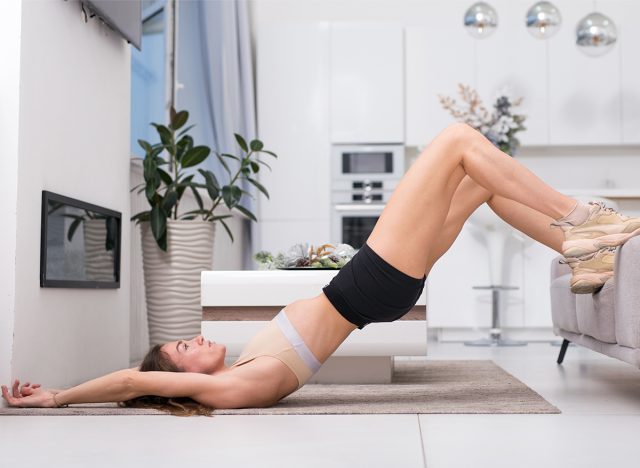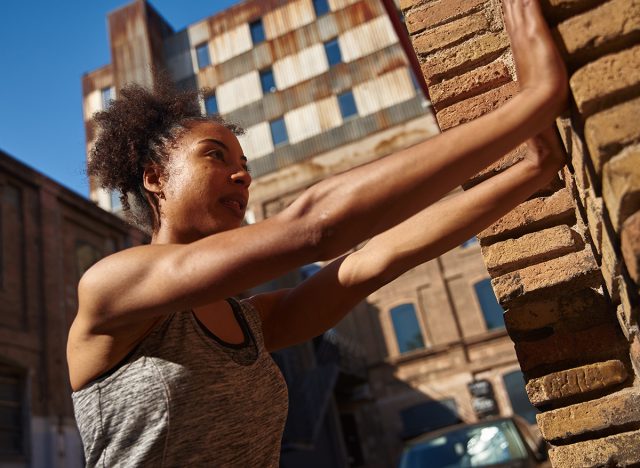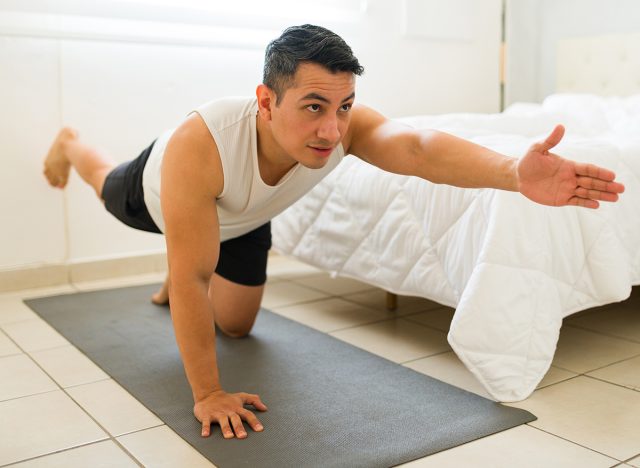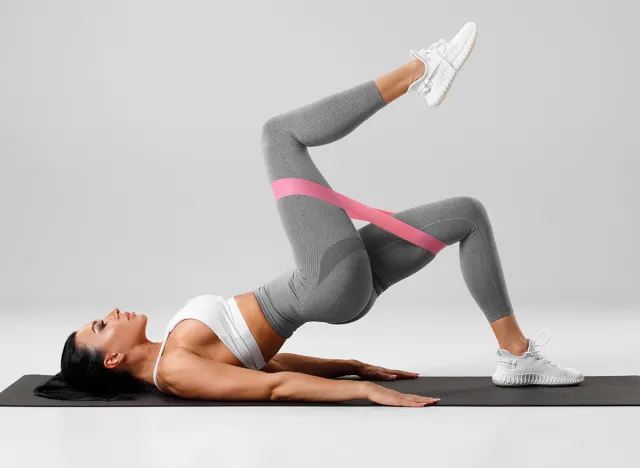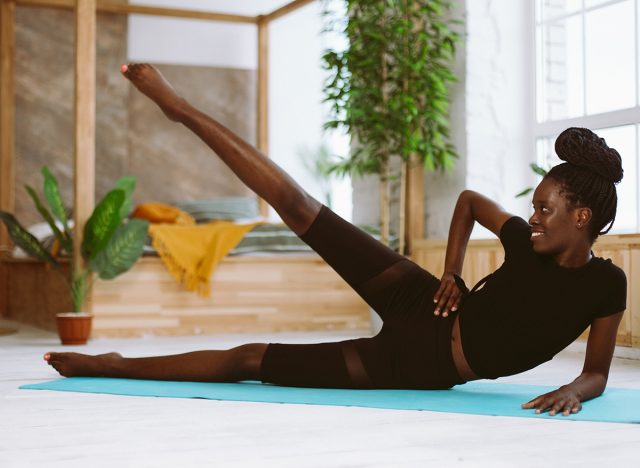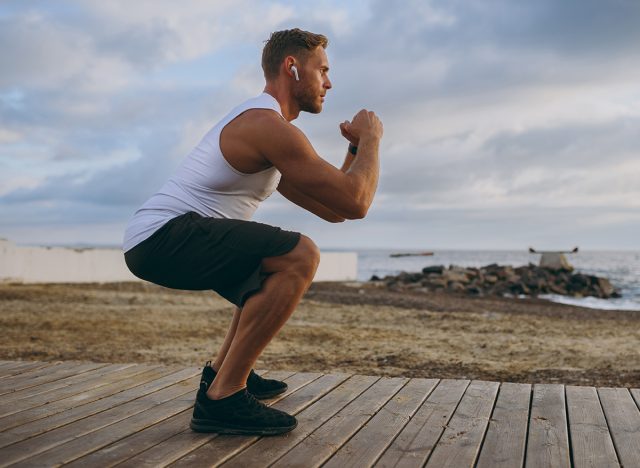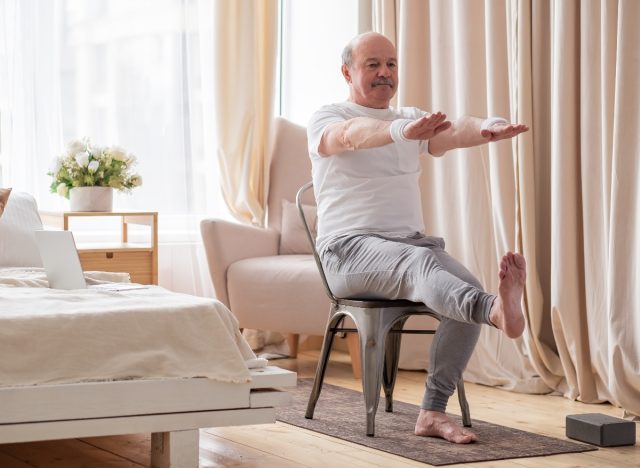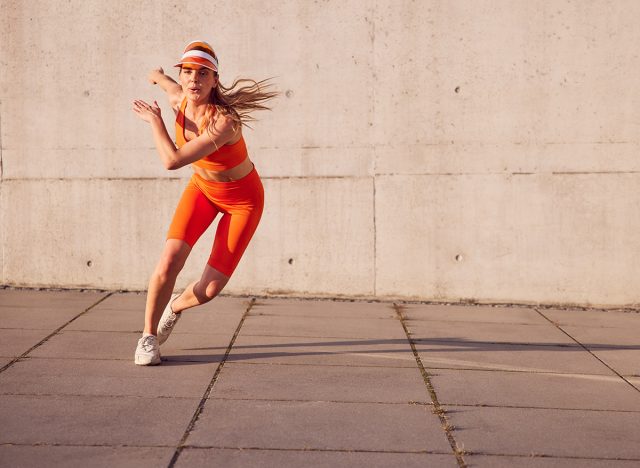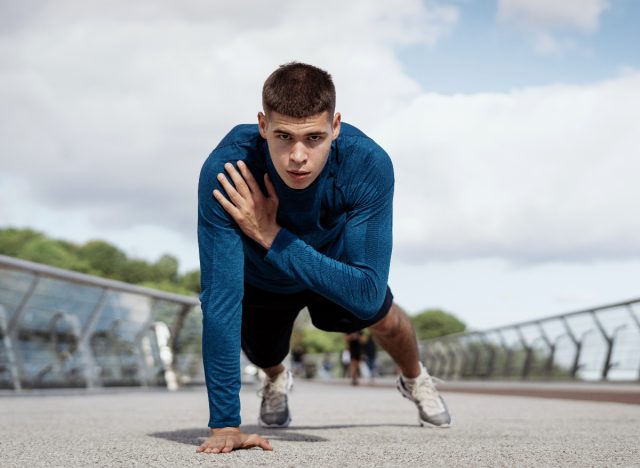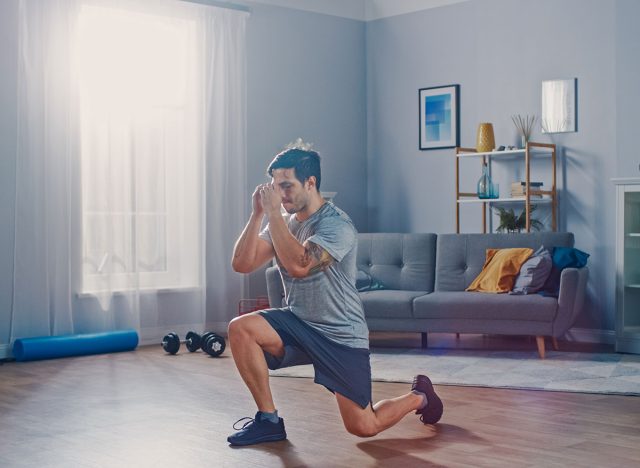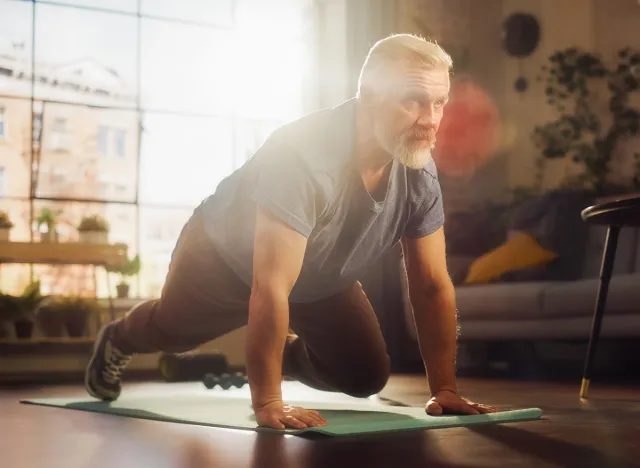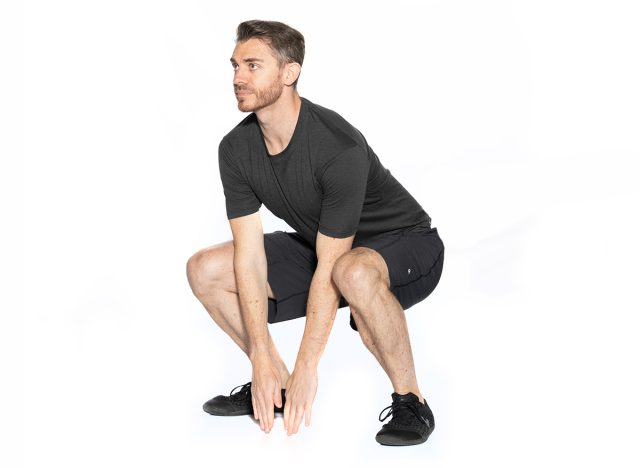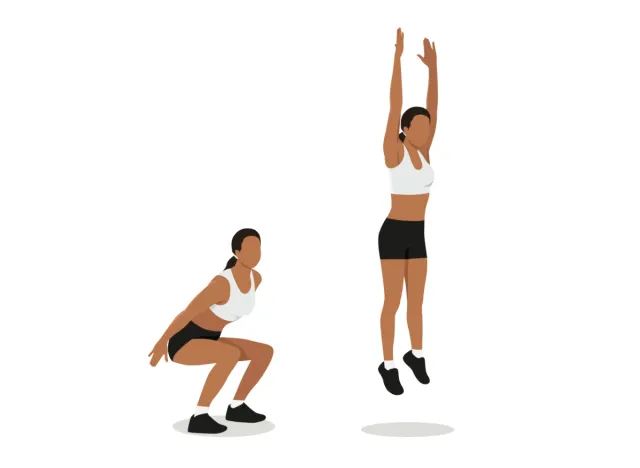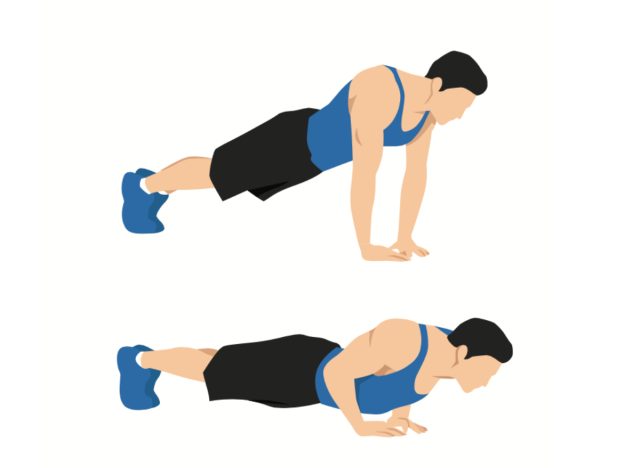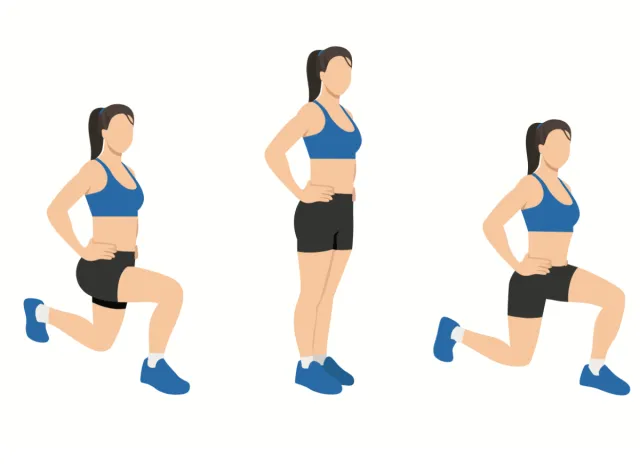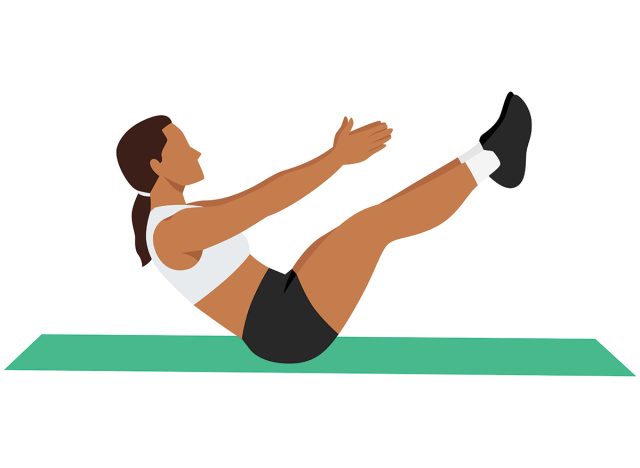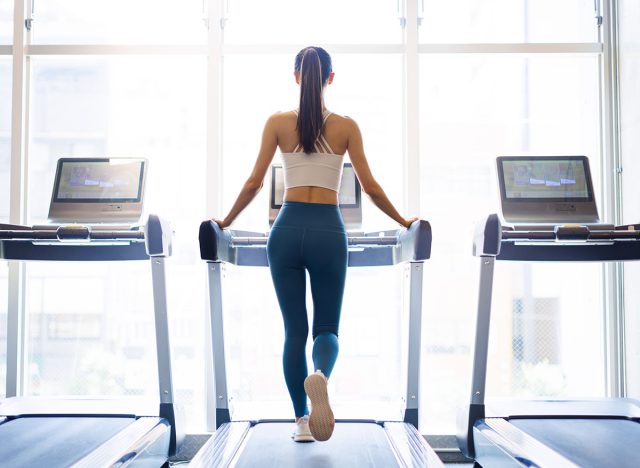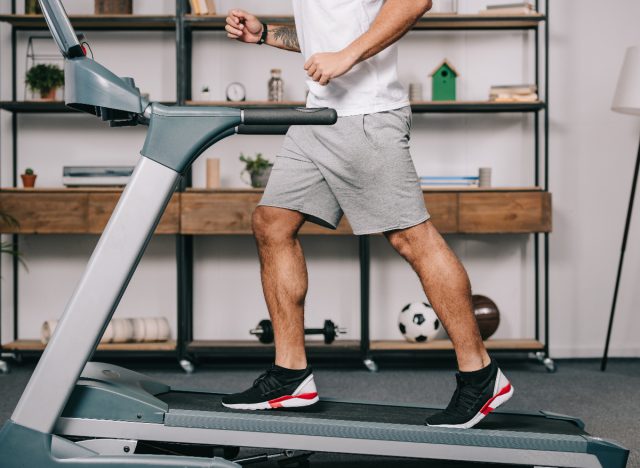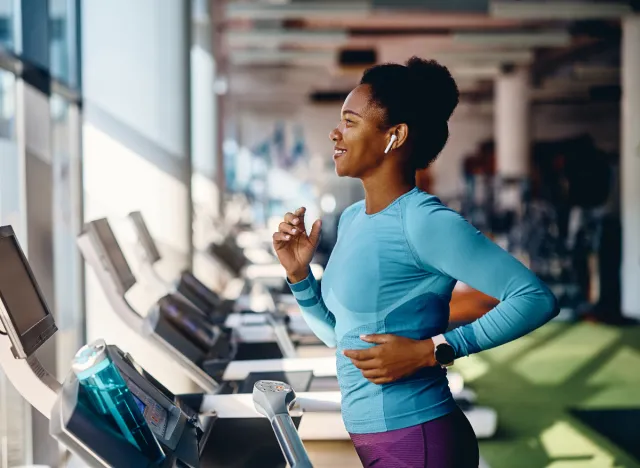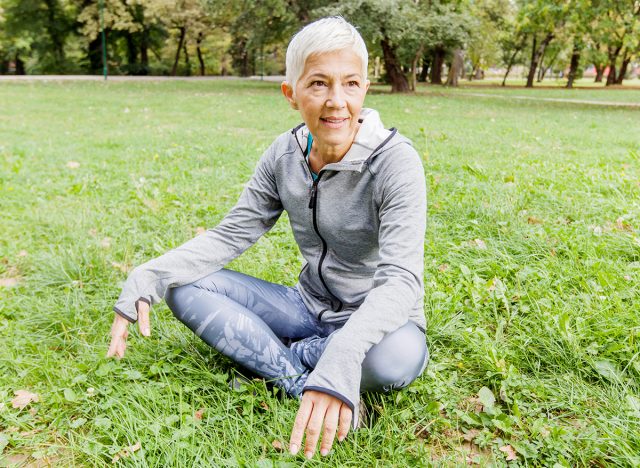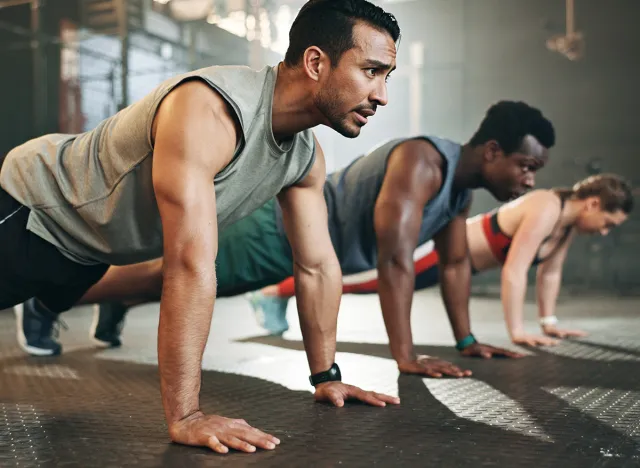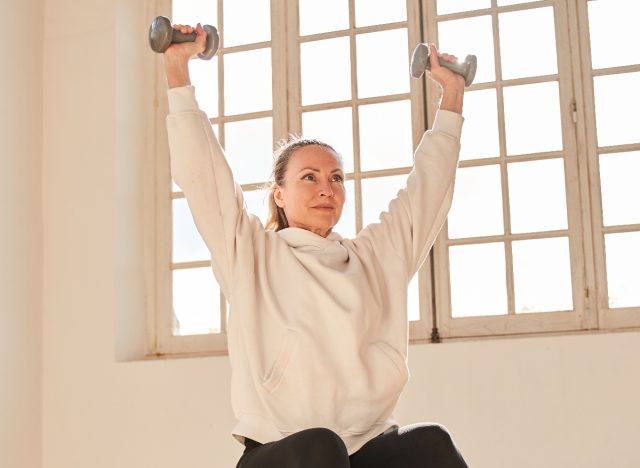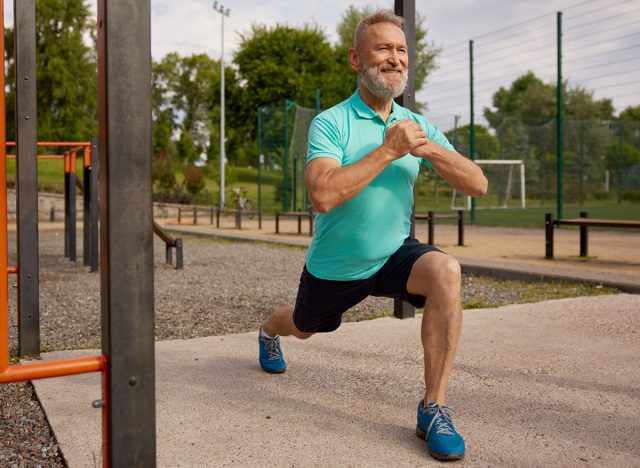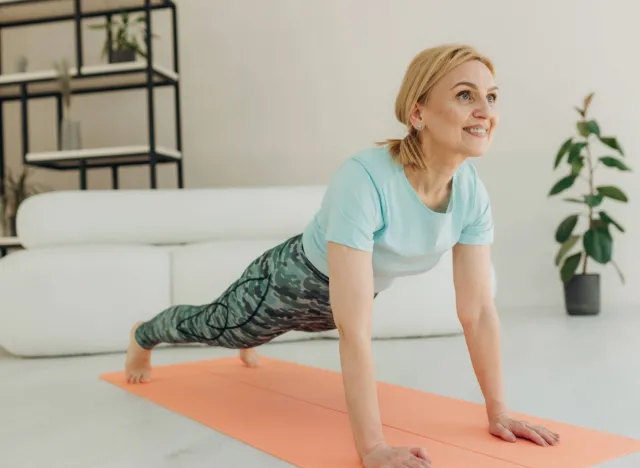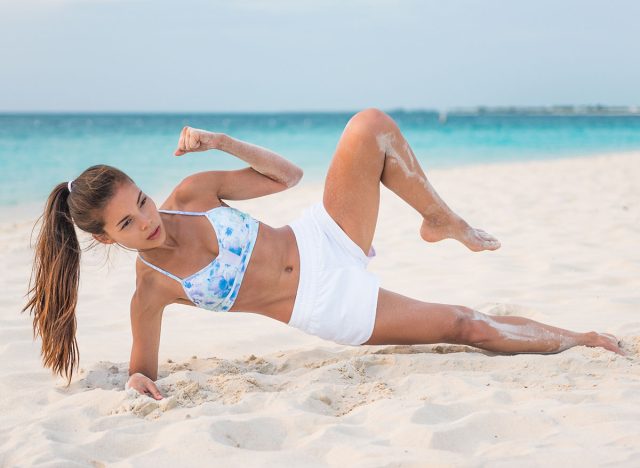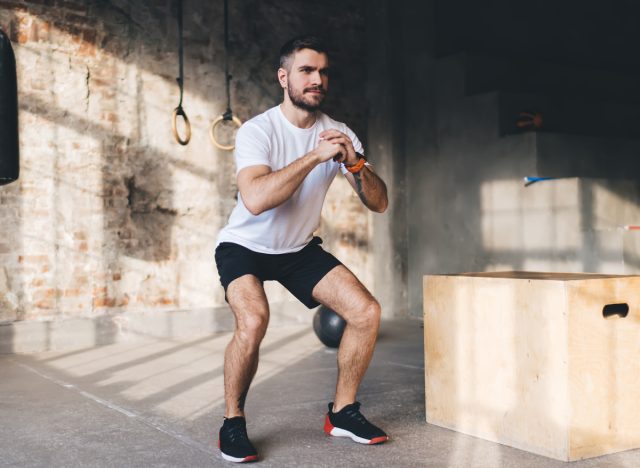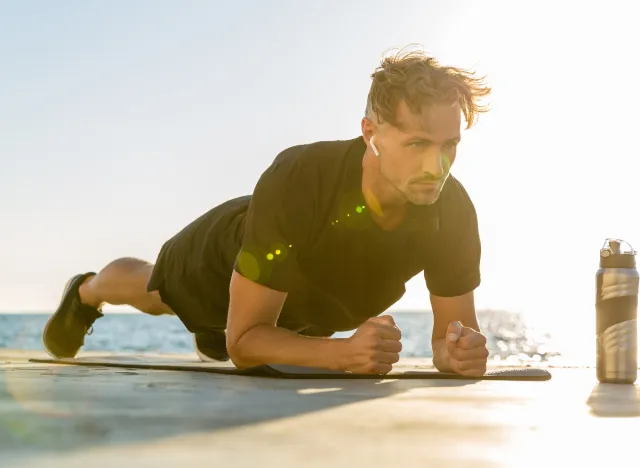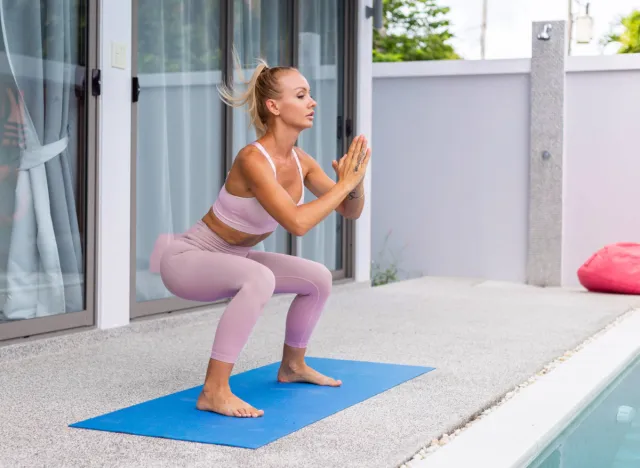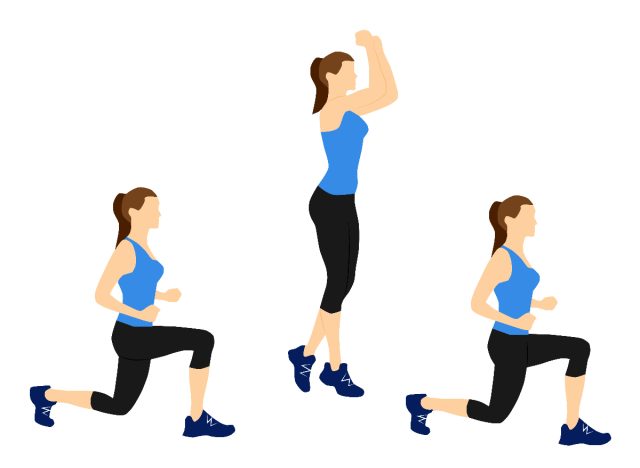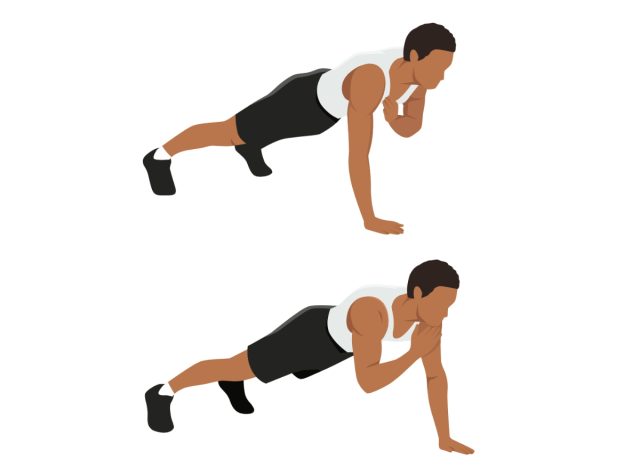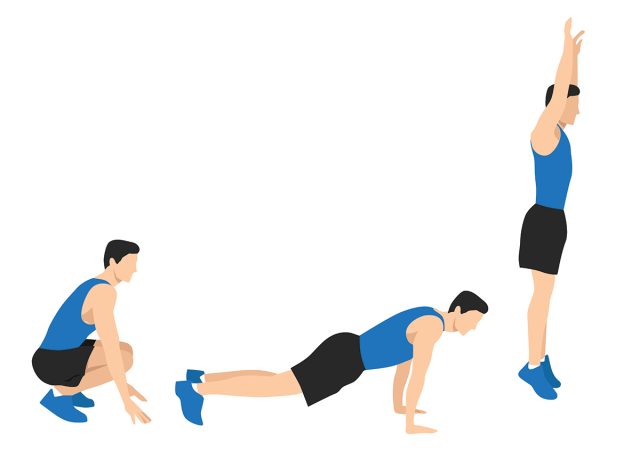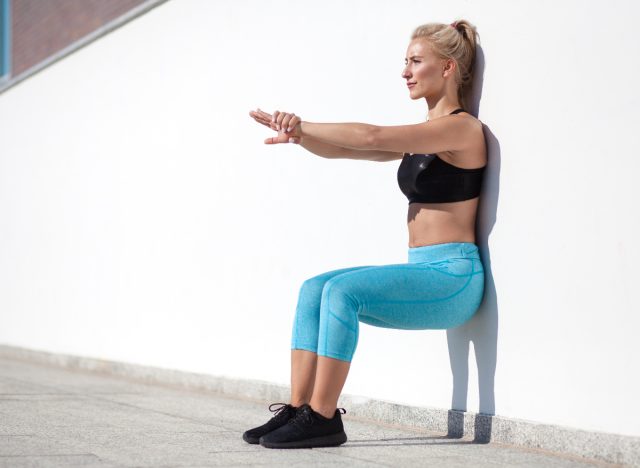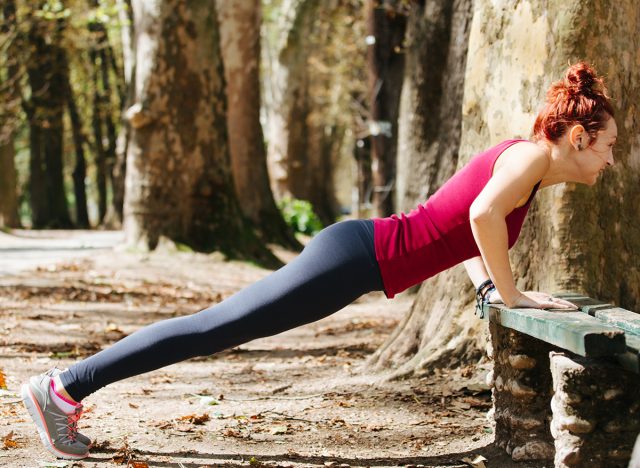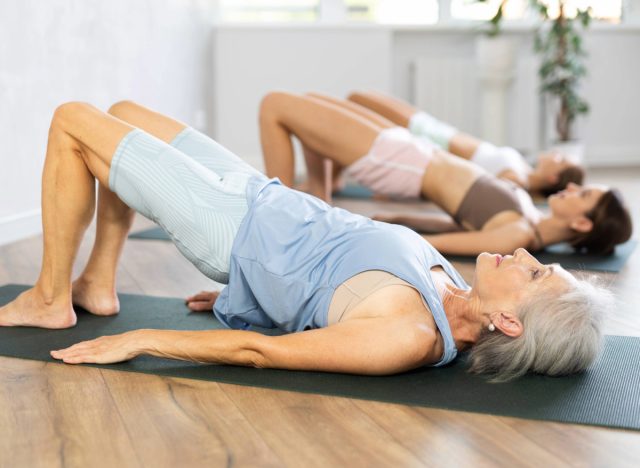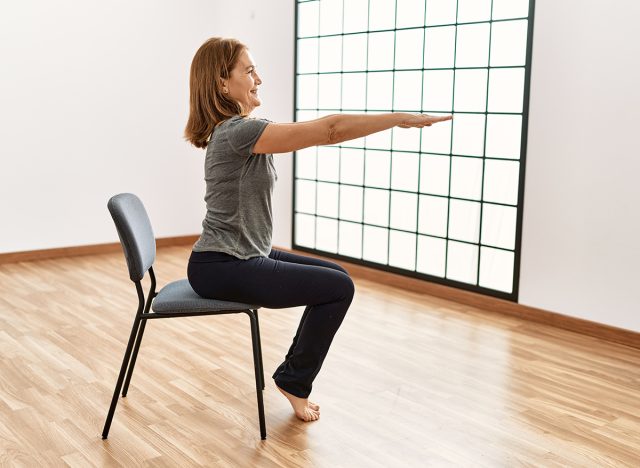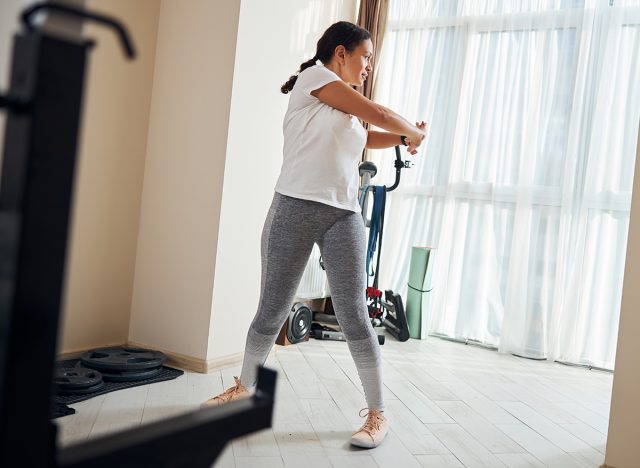Facial treatments are an incredibly popular skincare practice many celebs indulge in. There's a wide variety to choose from—and some are more extreme than others. Based on our favorite A-listers' glowing complexions, though, they may be worth trying. From vampire facials to salmon sperm treatments to even leeches, here are eight very unique facial treatments celebrities are obsessed with. 1. Salmon Sperm FacialThe salmon sperm facial gained traction in Korea and is seemingly making its way across the globe. According to WSJ Magazine (via FOX News), it's popular for reducing scars, brightening skin, and tightening pores. Our favorite "Friend," Jennifer Aniston, was all about getting one. Although, her initial reaction was, "Are you serious? How do you get salmon's sperm?" We had the same question, Jen! Other celebs who have hopped on the salmon sperm trend include Kim Kardashian and Denise Richards. For those curious, the treatment does not mean spreading salmon sperm all over your face. Rather, your skin is injected with polynucleotides, "micro-chains of salmon DNA" that come from salmon sperm, Women's Health reports. RELATED: 10 Life-Changing Skincare Products Our Editors Are Obsessed With 2. Vampire FacialA vampire "facelift" is a face revitalization treatment that's non-surgical, according to the Cleveland Clinic. It involves injecting platelet-rich plasma, along with hyaluronic acid filler, to your face. It contours, plumps up your skin, and lessens wrinkles. Kim Kardashian was a fan of vampire facials and posted a viral Instagram selfie about one of her experiences. She shared, "Before I got the procedure, I just found out that I was pregnant, so I couldn't use numbing cream or a pain killer and both are suggested. It was really rough and painful for me. I couldn't tell anyone about the pregnancy either, but I pulled Jonathan aside and told him" (via PEOPLE). 3. Epidermal Growth Factor FacialAn epidermal growth factor facial involves applying a "natural protein" to your facial skin that promotes new cells and collagen production. It's celebrated for reducing wrinkles, improving skin texture, and resulting in a glowing complexion. Sandra Bullock is reportedly all about epidermal growth factor facials. She even convinced her Ocean's 8 co-star, Cate Blanchett, to try one. "Sandy Bullock and I saw this facialist in New York, Georgia Louise, and she gives what we call the penis facial and it's something—I don't know what it is, or whether it's just 'cause it smells a bit like sperm—there's some enzyme in it so Sandy refers to it as the penis facial," Cate previously told Vogue Australia of her experience (via TODAY). RELATED: 9 Foods Beauty Experts Swear Will Give You Clearer Skin 4. LeechesThis particular facial definitely falls under the very unique ones category—and likely not for the faint of heart. Live leeches are put on your face to basically consume blood. It's then spread to tighten the skin and provide a youthful look. Demi Moore revealed on an episode of The Late Show, as reported by FOX News, that she got leech therapy done. "It detoxifies your blood," the actress explained. "And they have a little enzyme that, when they're biting down on you, gets released into your blood, and generally you bleed for quite a bit. And your health is optimized. It detoxified the blood, and I'm feeling detoxified right now." 5. Bee Venom FacialIf you're not allergic to bees, a bee venom facial may be an option to consider—but tread with caution and bee careful. Do your research. It involves a facial using "skin-plumping products" that contain a patented bee venom known as Abeetoxin, according to Essence. Fans of the facial include Victoria Beckham, Beyonce, and Gwyneth Paltrow. Gwyneth and her iconic Goop brand are known to push the limits when it comes to natural beauty remedies and products. Fun fact? Even Kate Middleton had a bee venom facial prior to getting hitched, according to Cosmo. RELATED: 14 Best Foods For Your Skin, According to Dietitians 6. Mono-ThreadingMono-threading is a process of inserting absorbent threads into the skin. The benefits? Wrinkle reduction, tighter skin, collagen production, and overall youthfulness. Eva Mendes is on team mono-threading and shared a selfie on Instagram of herself getting the treatment at Beauty Villa Vergara. Eva wrote in the caption, "Here I am getting some Mono-Threads. Ayyyy Dios!" RELATED: 31 Foods You Can Use for an At-Home Facial 7. Diamond and Ruby FacialThey say diamonds are a girl's best friend, and Mila Kunis may agree. A $7,000 diamond and ruby facial will buy the procedure that utilizes "precious stones," aka diamonds and rubies, that are used as antioxidants on your skin, according to Forbes. Mila's facialist, Scott Vincent-Borba, shared with InStyle, as reported by ELLE, that the actress does this for the red carpet. "I always do [this on] her skin, neck, decollete, arms, and the back of her hands. Anything that will be possibly showing with her dress," Scott said. 8. Hemorrhoid CreamOkay, don't judge. Hemorrhoid can actually be somewhat of a miracle product for wrinkles, undereye bags, and even acne. Sandra Bullock is drop-dead gorgeous, and she's a fan of using hemorrhoid cream on her face for a little extra TLC. Kim Kardashian's makeup artist has used it as well. Sandra explained (via Vogue), "I didn't realize that putting hemorrhoid ointment on your face is acceptable in the beauty business. But apparently, butt cream helps lines around the eyes!" The post 10 Wild Facial Treatments Celebs Are Obsessed With appeared first on Eat This Not That. Медиа: | ↑ |
You don't need a gym full of equipment to start building real, functional muscle. Your own bodyweight is one of the most underrated tools for gaining strength and definition, if you know how to use it. When done right, bodyweight movements challenge major muscle groups, improve control, and drive progress in both strength and endurance. These exercises don't just work muscles, they also train your body to move better and more efficiently. You'll build power, coordination, and resilience without ever touching a dumbbell. Whether you're traveling, short on time, or simply prefer to train at home, these four moves deliver the muscle-building benefits you're after. Set aside about 15–20 minutes. All you need is your body, some floor space, and the willingness to push yourself with purpose. Perform each move for 45–60 seconds, rest 15–20 seconds between, and repeat for 3–4 rounds. Elevated Pike Push-Up
The Elevated pike push-up targets your shoulders, upper chest, and triceps like a bodyweight overhead press. By elevating your feet and shifting your torso vertically, you increase the load on your shoulders and fire up those pressing muscles. Elevated pike push–ups also challenge your core to stabilize your body throughout the movement. If you're after strong, defined shoulders without equipment, this is the move to master. How to do it:
Tempo Bulgarian Split Squat
The tempo Bulgarian split squat hits your quads, glutes, and hamstrings while demanding serious balance and coordination. Adding a slow tempo increases time under tension, which builds more muscle without needing external weight. You'll feel your legs working harder as they stabilize and power through the controlled motion. It's one of the most effective ways to sculpt strong lower-body muscles with just your bodyweight. How to do it:
Wall Walks
Wall walks demand full-body strength with an emphasis on shoulders, chest, arms, and core. The wall walk mimics the movement pattern of a handstand walk, offering a tough bodyweight challenge that builds muscle and coordination. You'll activate your entire upper body while your core works to control every inch of movement. It's intense, rewarding, and great for upper-body hypertrophy without equipment. How to do it:
Feet-Elevated Glute March
The elevated foot march strengthens your glutes, hamstrings, and core all at once. Elevating your feet increases the range of motion and makes your posterior chain work even harder. The alternating leg march builds unilateral strength and improves balance between sides. If you want strong, sculpted glutes without loading a barbell, this is a must-do. How to do it:
The post 4 Muscle-Building Moves That Don't Require a Single Weight appeared first on Eat This Not That. Медиа: | ↑ |
You don't need high-impact jumping or heavy weights to get your heart rate up and burn fat. In fact, the smartest fat-loss routines are often the ones that protect your joints while still pushing your muscles to work hard. Whether you're recovering from an injury, managing joint pain, or just want to train smarter, low-impact doesn't mean low results. The key is to focus on controlled, compound movements that challenge your core, activate major muscle groups, and keep your body moving with purpose. These bodyweight exercises are designed to minimize strain on your knees, hips, shoulders, and back, while still building strength, endurance, and metabolic intensity. They're quiet, steady burners that deliver consistent progress without punishing your body. All six moves can be done in one smooth circuit. Do each for 45 seconds with 15 seconds of rest between. Aim for 2–3 rounds total. No equipment, no pounding, just powerful movement that keeps your joints safe and your fat loss on track. Wall Push-Up to Reach
Wall push-ups builds strength in your chest, shoulders, and triceps while keeping pressure off your wrists and elbows. The added reach activates your core and upper back, turning a basic movement into a total-body challenge. It's ideal for beginners or anyone needing a joint-friendly push-up variation that still gets results. The controlled tempo is what makes it effective. How to do it:
Bird Dog Reach and Squeeze
The bird dog exercise strengthens your abs, glutes, and lower back with zero joint impact. The slow, controlled reach forces deep core engagement while the squeeze at the top reinforces balance and body awareness. It's one of the safest and most effective moves for building functional strength and protecting your spine. How to do it:
Glute Bridge March
Glute bridges target the glutes, hamstrings, and lower abs while keeping your hips and knees in a stable position. The marching motion adds dynamic tension to the core and develops unilateral strength and control. It's a great way to build lower-body power without putting pressure on your joints. How to do it:
Side-Lying Leg Circles
Side-lying leg circles hit the outer thighs, hips, and obliques with precision. Because you're lying down, it completely eliminates joint impact while still creating deep muscular activation. The circular motion enhances hip mobility and improves joint stability, especially useful for those who sit all day long. How to do it:
Half Squat Pulse
The half squat pulse builds strength in the quads and glutes without requiring deep knee flexion or impact. Staying in the bottom half of a squat forces your muscles to stay under tension and keeps the movement controlled. It's ideal for maintaining leg strength and boosting calorie burn while being gentle on the knees. How to do it:
Seated Knee Extensions
The seated knee extension targets your quads and core with zero pressure on the joints. It's especially effective for activating the front of your thighs and improving circulation in the lower body. Plus, the seated knee extension trains your posture without any special equipment. How to do it:
Continue alternating sides with strong, deliberate motion. The post 6 Bodyweight Moves That Burn Fat Without Hurting Your Joints appeared first on Eat This Not That. Медиа: | ↑ |
When it comes to shedding stubborn belly fat, cardio isn't just a box to check, it's your engine for transformation. But not all cardio is created equal. If you're spending endless time jogging and still not seeing results, it might be time to rethink your strategy. The best fat-burning cardio moves don't just get your heart rate up, they fire up your core, engage multiple muscle groups, and keep your metabolism elevated long after the workout ends. The key is intensity and movement efficiency. These are the go-to moves that deliver results when you need to feel the burn and see change fast. They're powerful, they're functional, and they're designed to work your body from the inside out. Whether you've got 10 minutes or half an hour, this style of training is where serious fat loss begins. You won't need any equipment, just your bodyweight and a willingness to push. Do each movement for 45 seconds with 15 seconds of rest between. Complete 2–3 rounds for a killer cardio core blast that can be done anywhere, anytime. Lateral Skater Hops
The lateral skater hop strengthens the legs and glutes while spiking your heart rate. By jumping side to side, you activate stabilizing muscles and force your core to work overtime to control each landing. It's a high-energy move that mimics the dynamic action of skating, making it ideal for fat burn and lower-body conditioning. Plus, skater hops improve agility, balance, and coordination all in one. How to do it:
Plank Jack to Shoulder Tap
The plank jack with shoulder tap turns a static core hold into a dynamic calorie scorcher. The plank jack elevates your heart rate, while the shoulder tap challenges your stability and coordination. Together, they hit your shoulders, chest, abs, and glutes in one seamless motion. It's efficient, intense, and ideal for targeting belly fat while building strength. How to do it:
Jump Lunge Switches
Jump lunge switches deliver a serious burn in your legs and glutes while cranking your heart rate. The explosive switch from one leg to the other recruits fast-twitch muscle fibers and taxes your cardiovascular system. It also improves balance, coordination, and muscular endurance. If you want an all-in-one move for strength and fat loss, this one delivers. How to do it:
Mountain Climber Sprints
A faster, more intense version of the classic mountain climber, the mountain climber sprint brings together cardio and core in one high-octane package. You'll torch calories fast while building endurance, coordination, and lower ab strength. The sprint pace keeps the intensity high and your metabolism fired up. It's a staple move for a reason, it just works. How to do it:
Frog Jumps
Frog jumps target your quads, glutes, and core while sending your heart rate through the roof. Frog jumps mimic the explosive squat motion and build lower-body strength while maximizing calorie burn. Because frog jumps require both strength and speed, they're especially effective for fat loss and metabolic conditioning. They're tough, but they get results. How to do it:
Keep your chest lifted and your movements powerful and controlled. The post 5 Cardio Moves Trainers Swear By for Burning Belly Fat Fast appeared first on Eat This Not That. Медиа: | ↑ |
When time is tight or the gym is out of reach, bodyweight workouts step in as a powerful solution. Don't underestimate them; your body can be the ultimate fitness tool. With gravity, space, and sheer determination, you can build lean muscle, torch calories, and boost your endurance. The secret sauce? Effort and intensity. It's about how hard you push. Go all in with each rep, minimize distractions, and unlock results rivaling any gym session. This workout is fast, effective, and built to get your muscles firing and your heart pumping. Below, you'll find a zero-equipment interval workout designed to help you build muscle and burn fat—anytime, anywhere. The No-Equipment WorkoutWhat You Need: There is no equipment—just your bodyweight, a timer, and a small space. This workout takes about 20 to 25 minutes to complete. You'll perform four bodyweight exercises in a 30-second on / 30-second off format. One round takes four minutes. Rest two minutes between rounds and complete four to five rounds, depending on your fitness level. The Routine:
Directions: Perform each exercise for 30 seconds of work, followed by 30 seconds of rest. Complete the exercises in order. After each round, rest for 2 minutes. Push your pace during each work period and reset during the rest. How to Do It: Jump Squats
How to do it:
Close-Grip Push-Ups
How to do it:
Walking Lunges
How to do it:
V-Ups
How to do it:
Coach Tips for the Best WorkoutThis workout only delivers results if you bring the effort. To maximize muscle-building and fat-burning benefits, follow these training tips from a coach's playbook:
The post The No-Equipment Workout That Builds Muscle and Burns Fat Fast appeared first on Eat This Not That. Медиа: | ↑ |
How fit are you? You can lift weights, jog for miles, and even knock out a solid circuit. But there's something about a short, all-out challenge that cuts through the fluff and gives you a brutally honest answer. That's what this one-minute treadmill test delivers. Sixty seconds. Maximum effort. No excuses. You'll jump on, sprint hard, and watch the calories rack up like your fitness depends on it, because it kind of does. It's a raw test of power, endurance, and grit. It's fast, measurable, and repeatable. No guesswork. Just a pure, stripped-down fitness test you can do anytime you need a gut check or a burst of calorie-burning chaos. Ready to find out what one minute of work can do? The One-Minute Treadmill Test
The goal is simple. Burn as many calories as possible in one minute on the treadmill. Sprint hard, go fast, and push your threshold. How to Do It:
This test takes less time than a microwave meal but hits your system like a truck. Why It Works
You're using some of the biggest muscles in your body, your glutes, quads, hamstrings, and calves, while driving your heart rate through the roof. That's a powerful combo for burning fat—sprinting taps into your anaerobic system, which forces your body to work without oxygen for short bursts. This training style triggers a post-exercise calorie burn called EPOC (excess post-exercise oxygen consumption), which means you keep burning calories even after you stop moving. Short, intense efforts like this also build speed, power, and mental toughness. You don't just burn fat; you get faster and fitter. What's a Good Score?Here's a general breakdown of calorie benchmarks to aim for. Keep in mind, different treadmills measure slightly differently, but this gives you a rough idea:
Hit that elite zone, and you're in rare company. How to Get Better (and Burn More Fat)
Want to boost your score next time? Good. That means you're hungry for progress. Here's how to build capacity:
Need a Modified Version?If sprinting isn't in the cards, try this instead: Walk on a 10 to 12% incline quickly for one minute and track calories or distance. It won't burn as much but will still get your heart pumping and offer a safer challenge. Who Should Skip This Test?If you haven't run or sprinted in a long time or have joint, heart, or mobility issues, check with a healthcare provider or trainer before going all-out. This test demands a lot quickly, and you must be ready. Your One-Minute Fitness Check-InThis test takes little time but tells you a lot. It measures power, speed, heart rate, and how much you will push yourself in sixty seconds. You'll finish breathless, sweaty, and maybe a little surprised by your capabilities. Try it today. Log your score. Challenge a friend. See what happens when you push the gas pedal down. Because one minute is all it takes to spark a change. The post The One-Minute Fat-Burning Test You Should Try Right Now appeared first on Eat This Not That. Медиа: | ↑ |
Want to add more healthy years to your life? You're not alone. A 2023 Talker Research survey revealed that 33 percent of U.S. adults want to prioritize healthy aging as a top goal for 2025, making it one of the year's biggest health trends. One of the most effective ways to age gracefully is by maintaining the foundational movements that keep your body strong and functional. We spoke with Lola Lopez Guardone, CPT, an ACE-certified personal trainer with FitForAll, who shares five simple yet powerful exercises to improve strength, mobility, and balance to help you thrive at any age. "Your ability to move well is a powerful indicator of your overall health and longevity," Guardone explains. "Strength, flexibility, balance, and coordination aren't just fitness goals—they're essential skills for maintaining independence, preventing injuries, and staying active for life." As you age, it's common for basic movements to become more challenging or overlooked. This is risky business, considering the National Institutes of Health says the natural loss of strength, flexibility, and coordination that occurs with aging can lead to a higher risk of falls and fractures. However, regularly incorporating these foundational exercises can help preserve your functional health and prevent premature aging. So, whether you're finding it harder to get off the floor or experiencing stiffness in your daily activities, these essential movements are vital markers of your body's overall health and longevity. The way we move tells a lot about our overall health. Movements that challenge multiple muscle groups, improve stability, and maintain flexibility are crucial for aging bodies. If you find these moves more challenging than you used to, it could indicate muscle loss, mobility issues, or a decline in neurological health. Luckily, these issues are reversible with consistent practice. Read on to discover the five basic movements that everyone should be able to perform, regardless of age. When you're finished, be sure to check out The 60-Second Strength Test That Reveals Your True Fitness Age. Sit-to-Stand (Ground to Standing)
The sit-to-stand movement challenges your entire lower body, such as your hips, quads, and glutes, all while also testing your balance. It's a fundamental functional movement that reflects your strength and stability. "Struggling to stand without hands often reflects lower-body weakness, balance loss, or reduced hip/knee mobility," Guardone says. Guardone recommends practicing sit-to-stands from a sturdy chair and gradually progressing to floor-to-stand variations. Repeating this movement will build muscle and mobility in your legs, hips, and core. Horizontal Push/Pull
Horizontal pushing and pulling movements are critical for building upper-body strength and supporting healthy posture. These exercises target your chest, back, and shoulder muscles, which are key for maintaining a strong upper body. Difficulty with push-ups or rows can indicate weak chest, back, and shoulder muscles, which could lead to poor posture, shoulder issues, and overall reduced upper-body endurance. Guardone explains, "Weak push or pull strength can contribute to rounded posture, shoulder dysfunction, and reduced upper-body endurance." If normal push-ups are too difficult, try incline push-ups to build strength progressively. For pulling movements, try doing rows using resistance bands or TRX. Aim for two to three sessions per week. Vertical Push/Pull
Vertical pushing and pulling movements help maintain shoulder mobility and strength, which are crucial for lifting, reaching, and overall upper-body mobility. Guardone says, "Limited range overhead or pulling weakness often signals shoulder mobility loss and upper-body imbalance." Struggling with vertical movements could signal limited shoulder mobility or upper-body imbalance, which can affect everything from lifting to simple daily tasks like reaching for something on a high shelf. Add overhead presses (with light weights or resistance bands) and assisted pull-ups or lat pulldowns into your routine. These movements will help strengthen your shoulders and upper back to boost your strength and range of motion. Single-Leg Balance (Lunge/Split Squat Pattern)
"Single-leg strength is crucial for walking, climbing stairs, and preventing falls," Guardone says. This movement targets your hips and glutes, which support posture and mobility. Additionally, difficulty with lunges or split squats can indicate poor balance, weak hip muscles, or knee instability, leading to an increased risk of falls or fractures. Try incorporating assisted lunges or static split squats into your fitness routine. Aim for two or three sessions per week. Anti-Rotational Stability (Core Control)
"Anti-rotational strength stabilizes your spine, improves balance, and protects against back pain," Guardone explains. If your core can't stabilize during planks or deadbugs, you may have weak deep-core muscles and reduced trunk control, which can lead to lower back pain and poor posture. To fix this, add core exercises like plank shoulder taps, bird dogs, and deadbugs to your workouts two or three times a week. The post If You Can't Do These 5 Moves, Your Body May Be Aging Too Fast appeared first on Eat This Not That. Медиа: | ↑ |
Do you want to blast your belly fat before summer? Do this simple routine a few times weekly, and watch your belly shrink. Celebrity fitness trainer and health and wellness expert Jenna Willis designs strength training routines for her A-list clients, including Camila Cabello and Lala Kent. "If you're looking to tighten up your core and feel strong AF without any equipment, these 5 no-equipment moves will hit your belly, glutes, arms, and everything in between. Do them consistently, and in 30 days, you'll feel (and see) the difference," she tells us. She recommends repeating two to three times, based on your time and energy, and doing the workout three to four times a week. High Plank Shoulder Tap to Knee Tuck (45 sec)
The first exercise is high plank shoulder tap to knee tuck. "Start in a high plank. Tap your right hand to your left shoulder, then your left hand to your right. After two taps, drive one knee toward your chest, then the other. That's one rep. Keep your hips steady," Willis recommends. Side Plank Crunches (30 sec/side)
Next up, side plank crunches. "In a forearm side plank, lift your top arm overhead. Twist and reach it under your waist as you crunch in, then return to start. Hips stay lifted—your obliques are doing the work here," she says. Squat to Standing Cross-Body Knee Drive (45 sec)
A squat to standing cross-body knee drive is the next exercise she recommends. "Sit low into a squat with your weight in your heels. As you stand, drive one knee up and across toward the opposite elbow. Alternate sides," Willis says. Forearm Plank Walk Out to Pike Jack (45 sec)
The fourth exercise is a forearm plank walk out to pike jack. "From a forearm plank, walk one arm out at a time (like you're crawling forward), then return to center. After each walk-out, jump both feet in toward your hands into a pike position, then back out," says Willis. Lateral Thrust Pops (45 sec)
The final exercise? Lateral thrust pops. "Drop into a 3/4 squat, torso angled slightly to one side. Explode up, feet together, and twist your torso forward like you're throwing energy. Land soft, reset into that squat, and repeat fast," she says. The post 5 No-Equipment Moves To Target Belly Fat in 30 Days appeared first on Eat This Not That. Медиа: | ↑ |
When you don't have time to spare but want a workout that leaves your lungs gasping and your muscles on fire, bodyweight training delivers. No gym, no problem. Just your body, a bit of space, and a willingness to push your limits. You can build considerable intensity in minutes if you pair the right exercises with the proper format. The secret? Creativity. Combining explosive, compound movements turns any small workout window into a high-octane fat-burning furnace. Dynamic combos like jumps, taps, and powerful bursts spike your heart rate, challenge your whole body, and ignite your metabolism long after your last rep. And when you go hard, short sessions are all you need. This three-move bodyweight combo seamlessly blends athleticism, strength, and cardio into one brutal yet effective package. Here's how to do it—and three fast workout formats to torch calories in under 6 minutes. Move: Alternating Lunge Jumps
Lunge jumps load your lower body while challenging balance and coordination. You'll hammer your glutes, quads, and hamstrings with every rep—and since you're switching legs mid-air, your core and stabilizers get fired up too. The explosive nature of the move cranks your heart rate and scorches calories. Muscles Trained: Quads, glutes, hamstrings, calves, core How to Do It:
Pro Tip: Land light and low. Think "quiet feet"—it saves your joints and forces better control. Move: Push-Up + Shoulder Taps
This hybrid move targets your chest, shoulders, triceps, and core simultaneously. The push-up builds upper body strength and drives up your heart rate. The shoulder taps force your core to stabilize under tension, training your body to resist rotation and maintain total-body control. Muscles Trained: Chest, shoulders, triceps, core. How to Do It:
Pro Tip: Slightly widen your feet for improved balance during the taps. Don't rush—form first, speed second. Move: Burpee Broad Jump
This is your all-in-one fat burner. The burpee demands speed, coordination, and full-body effort. Add a broad jump, and you get an explosive lower-body power move that requires even more oxygen—and scorches even more calories. Muscles Trained: Chest, shoulders, quads, glutes, hamstrings, core How to Do It:
Pro Tip: Land soft and stay loaded. Don't let your knees cave in—stay athletic from jump to jump. The Best Workouts to Burn Fat Under 6 MinutesYou don't need an hour to make serious progress—just six minutes of focused intensity. These fast-paced workouts utilize explosive, full-body movements to elevate your heart rate, engage your muscles, and burn fat quickly. Pick your favorite format, hit the timer, and get after it. Workout #1 6-Minute AMRAPWhat you need: Just your body and a timer. This 6-minute AMRAP (as many rounds as possible) challenges your endurance and mental grit. The Routine:
Directions: Set a timer for 6 minutes. Complete as many rounds as possible of the exercises above, in order. Keep rest to a minimum. Stay controlled but push your pace. Track your rounds and try to beat it next time. Workout #2: HIIT Intervals (:45/:15)What you need: A Timer and open space. This high-intensity interval format keeps you working hard with brief rest periods between rounds. The Routine:
Directions: Perform each move for 45 seconds, then rest for 15 seconds before moving on. Go through all six intervals for a total of 6 minutes. Focus on crisp, powerful reps with minimal rest, sloppiness. Workout #3: Ascending Ladder AMRAPWhat you need: A timer and grit. This ascending ladder starts easy—but don't let it fool you. It builds fast and gets brutal. The Routine:
Directions: Set your timer for 6 minutes. Start at 1 rep per exercise. Add 1 rep to each move every round. Keep climbing as high as you can go. Rest only if needed. Aim to beat your total reps next time. The post This 3-Move Bodyweight Combo Burns Fat in Under 6 Minutes appeared first on Eat This Not That. Медиа: | ↑ |
Age doesn't slow you down, lack of movement does. If you're over 50 and want to keep your energy up, your strength sharp, and your metabolism burning like used to, it's time to train with purpose. You don't need a complicated plan or hours in the gym. You need smart, functional exercises that wake up your entire body and keep your muscles working for you, not against you. Your metabolism naturally dips as you age, but the good news is you have more control over it than you think. When you focus on strength, balance, and mobility, you not only preserve lean muscle but you also boost calorie burn all day long. Muscle is your metabolic engine, and with the right moves, you keep that engine running hot. These five exercises are handpicked to hit all the right areas. They activate large muscle groups, improve balance and coordination, and build functional strength that translates into real-world energy. You can do them in under 20 minutes, no equipment required, right at home or anywhere you have space to move. Wall Sit with Heel Raise
Disguised as a static hold, wall sits activate your glutes, quads, and hamstrings all at once, while the added heel raise lights up your calves and challenges your balance. It's a total lower-body engagement that ramps up endurance and muscle activation. This combo not only strengthens your legs, it revs your engine by forcing multiple muscle groups to stabilize and support your body at the same time. How to do it:
Elevated Pushups
Elevated pushups (hands on a bench, counter, or sturdy surface) keep your upper body strong without overloading your joints. They fire up your chest, shoulders, triceps, and core, all essential for everyday strength and posture. Plus, pushups engage your metabolism by recruiting multiple muscle groups in one move. How to do it:
Glute Bridge
The glute bridge significantly activates your backside: glutes, hamstrings, and lower back. These muscles often go dormant with too much sitting, and that slows your metabolic engine. By firing them up, you not only increase your strength but also improve your ability to burn fat and stay mobile. It's also great for relieving lower back tension. How to do it:
Chair Sit-to-Stand with Pause
Don't underestimate the chair sit-to-stand, it's one of the most functional and effective exercises to build strength and boost metabolism as you age. Every time you sit and stand in daily life, your lower body and core go to work. This variation adds a pause at the top to increase time under tension, allowing your muscles to fire longer and work harder. It builds power in your glutes, legs, and core without needing any equipment. How to do it:
Standing Core Twist with Reach
The standing core twist with reaching combines core engagement with shoulder and back mobility. It's a low-impact way to wake up your spine, fire up your obliques, and stretch through the upper body. Standing core twists like this support better posture, coordination, and midline control, all key for keeping your metabolism working efficiently. How to do it:
The post Over 50? These 5 Exercises Keep Your Metabolism Fired Up for Life appeared first on Eat This Not That. Медиа: | ↑ |

